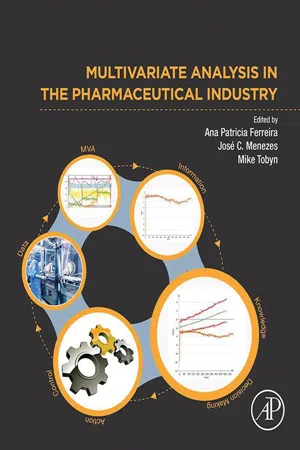
Multivariate Analysis in the Pharmaceutical Industry
- 464 pages
- English
- ePUB (mobile friendly)
- Available on iOS & Android
Multivariate Analysis in the Pharmaceutical Industry
About this book
Multivariate Analysis in the Pharmaceutical Industry provides industry practitioners with guidance on multivariate data methods and their applications over the lifecycle of a pharmaceutical product, from process development, to routine manufacturing, focusing on the challenges specific to each step. It includes an overview of regulatory guidance specific to the use of these methods, along with perspectives on the applications of these methods that allow for testing, monitoring and controlling products and processes. The book seeks to put multivariate analysis into a pharmaceutical context for the benefit of pharmaceutical practitioners, potential practitioners, managers and regulators.Users will find a resources that addresses an unmet need on how pharmaceutical industry professionals can extract value from data that is routinely collected on products and processes, especially as these techniques become more widely used, and ultimately, expected by regulators.- Targets pharmaceutical industry practitioners and regulatory staff by addressing industry specific challenges- Includes case studies from different pharmaceutical companies and across product lifecycle of to introduce readers to the breadth of applications- Contains information on the current regulatory framework which will shape how multivariate analysis (MVA) is used in years to come
Frequently asked questions
- Essential is ideal for learners and professionals who enjoy exploring a wide range of subjects. Access the Essential Library with 800,000+ trusted titles and best-sellers across business, personal growth, and the humanities. Includes unlimited reading time and Standard Read Aloud voice.
- Complete: Perfect for advanced learners and researchers needing full, unrestricted access. Unlock 1.4M+ books across hundreds of subjects, including academic and specialized titles. The Complete Plan also includes advanced features like Premium Read Aloud and Research Assistant.
Please note we cannot support devices running on iOS 13 and Android 7 or earlier. Learn more about using the app.
Information
Multivariate Analysis Supporting Pharmaceutical Research
Abstract
Keywords
7.1 Overview of Multivariate Analysis as a Part of Pharmaceutical Product Design
Table of contents
- Cover image
- Title page
- Table of Contents
- Copyright
- Dedication
- List of Contributors
- About the Editors
- Foreword
- Section I: Background and Methodology
- Section II: Applications in Pharmaceutical Development and Manufacturing
- Section III: Guidance Documents and Regulatory Framework
- Index